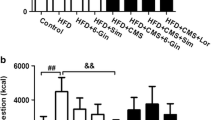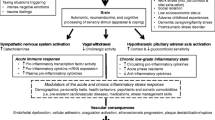Abstract
In the present study, we sought to investigate the effects of emotional and physiological stress on plaque instability in atherosclerosis. We used different stress-treated apolipoprotein E (ApoE)-deficient mice, which have been shown to spontaneously develop atherosclerosis with features similar to those seen in humans, as an animal model. Morphology study showed that emotional stress (ES) obviously promoted the development of atherosclerotic plaques and plaque instability evidenced by significantly increasing plaque size, plaque-to-surface ratio and plaque calcification, and enhancing the frequency of large necrotic core and medial erosion compared with control ApoE−/− mice (P < 0.01). Physiological stress (PS) treatment alone did not affect the plaque stability compared with control ApoE−/− mice (P > 0.05). However, the combination of ES and PS treatment (CS) initiated much stronger plaque instability compared with ES treatment alone (P < 0.01), increased the frequency of thin fibrous caps, and even triggered plaque rupture and buried fibrous cap. Immunohistochemical analysis indicated that both ES and CS treatment led to an increase in the accumulation of macrophages and T cells and a decrease of smooth muscle cells, reflecting an unstable atherosclerotic plaque phenotype, in the atherosclerotic lesions in ApoE−/− mice. PS alone did not affect plaque cellular components. Similarly, CS-mediated changes in atherosclerotic plaque composition were stronger than that caused by ES alone (P < 0.01). Taken together, ES treatment alone is sufficient to promote plaque instability. PS alone does not affect atherosclerotic plaque development, but can potentiate ES-mediated plaque destabilization.







Similar content being viewed by others
References
Abedin M, Tintut Y, Demer LL (2004) Vascular calcification: mechanisms and clinical ramifications. Arterioscler Thromb Vasc Biol 24:1161–1170
Barnett SA (1958) Physiological effects of social stress in wild rats. I. The adrenal cortex. J Psychosom Res 3(1):1–11
Barnett SA, Eaton JC, Mc CH (1960) Physiological effects of “social stress” in wild rats—II. Liver glycogen and blood glucose. J Psychosom Res 4:251–260
Bauriedel G, Hutter R, Welsch U, Bach R, Sievert H, Lüderitz B (1999) Role of smooth muscle cell death in advanced coronary primary lesions: implications for plaque instability. Cardiovasc Res 41:480–488
Berkman LF, Leo-Summers L, Horwitz RI (1992) Emotional support and survival after myocardial infarction. A prospective, population-based study of the elderly. Ann Intern Med 117:1003–1009
Blanchard DC, Spencer RL, Weiss SM, Blanchard RJ, McEwen B, Sakai RR (1995) Visible burrow system as a model of chronic social stress: behavioral and neuroendocrine correlates. Psychoneuroendocrinology 20(2):117–134
Bosma H, Peter R, Siegrist J, Marmot M (1998) Two alternative job stress models and the risk of coronary heart disease. Am J Public Health 88:68–74
Chapman I (1960) Anatomic and clinical significance of calcification of the aortic knob visualized radiographically. Am J Cardiol 6:281–286
Clarke MC, Figg N, Maguire JJ, Davenport AP, Goddard M, Littlewood TD, Bennett MR (2006) Apoptosis of vascular smooth muscle cells induces features of plaque vulnerability in atherosclerosis. Nat Med 12:1075–1080
Davies MJ, Thomas A (1984) Thrombosis and acute coronary–artery lesions in sudden cardiac ischemic death. N Engl J Med 310:1137–1140
Desai A, Zhao Y, Warren JS (2008) Development of atherosclerosis in Balb/c apolipoprotein E-deficient mice. Cardiovasc Pathol 17:233–240
Detrano RC, Doherty TM, Davies MJ, Stary HC (2000) Predicting coronary events with coronary calcium: pathophysiologic and clinical problems. Curr Probl Cardiol 25:374–402
Dijkstra H, Tilders FJ, Hiehle MA, Smelik PG (1992) Hormonal reactions to fighting in rat colonies: prolactin rises during defence, not during offence. Physiol Behav 51(5):961–968
Doherty TM, Detrano RC (1994) Coronary arterial calcification as an active process: a new perspective on an old problem. Calcif Tissue Int 54:224–230
Ehara S, Kobayashi Y, Yoshiyama M, Ueda M, Yoshikawa J (2006) Coronary artery calcification revisited. Atheroscler Thromb 13:31–37
Haller J, Fuchs E, Halasz J, Makara GB (1999) Defeat is a major stressor in males while social instability is stressful mainly in females: towards the development of a social stress model in female rats. Brain Res Bull 50(1):33–39
Hansson GK (2001) Immune mechanisms in atherosclerosis. Arterioscler Thromb Vasc Biol 21:1876–1890
Harris RB, Zhou J, Youngblood BD et al (1998) Effect of repeated stress on body weight and body composition of rats fed low- and high-fat diets. Am J Physiol 275(6 Pt 2):R1928–R1938
Kolodgie FD, Gold HK, Burke AP, Fowler DR, Kruth HS, Weber DK, Farb A, Guerrero LJ, Hayase M, Kutys R, Narula J, Finn AV, Virmani R (2003) Intraplaque hemorrhage and progression of coronary atheroma. N Engl J Med 349:2316–2325
Kumari M, Grahame-Clarke C, Shanks N, Marmot M, Lightman S, Vallance P (2003) Chronic stress accelerates atherosclerosis in the apolipoprotein E-deficient mouse. Stress 6:297–299
Libby P (1995) Molecular bases of the acute coronary syndromes. Circulation 91:2844–2850
Mallick J, Stoddart DM, Jones I, Bradley AJ (1994) Behavioral and endocrinological correlates of social status in the male sugar glider (Petaurus breviceps Marsupialia: Petauridae). Physiol Behav 55(6):1131–1134
Marti O, Marti J, Armario A (1994) Effects of chronic stress on food intake in rats:influence of stressor intensity and duration of daily exposure. Physiol Behav 55(4):747–753
Martinet W, Croons V, Timmermans JP, Herman AG, De Meyer GR (2007) Nitric oxide selectively depletes macrophages in atherosclerotic plaques via induction of endoplasmic reticulum stress. Br J Pharmacol 152:493–500
McGovern PG, Pankow JS, Shahar E, Doliszny KM, Folsom AR, Blackburn H, Luepker RV (1996) Recent trends in acute coronary heart disease—mortality, morbidity, medical care, and risk factors. The Minnesota Heart Survey Investigators. N Engl J Med 334(14):884–890
Meerlo P, Overkamp GJ, Daan S, Van Den Hoofdakker RH, Koolhaas JM (1996) Changes in behaviour and body weight following a single or double social defeat in rats. Stress 1(1):21–32
Mittleman MA, Maclure M, Sherwood JB, Mulry RP, Tofler GH, Jacobs SC, Friedman R, Benson H, Muller JE (1995) Triggering of acute myocardial infarction onset by episodes of anger. Determinants of Myocardial Infarction Onset Study Investigators. Circulation 92:1720–1725
Möller J, Hallqvist J, Diderichsen F, Theorell T, Reuterwall C, Ahlbom A (1999) Do episodes of anger trigger myocardial infarction? A case–crossover analysis in the Stockholm Heart Epidemiology Program (SHEEP). Psychosom Med 61:842–849
O’Malley PG, Taylor AJ, Jackson JL, Doherty TM, Detrano RC (2000) Prognostic value of coronary electron-beam computed tomography for coronary heart disease events in asymptomatic populations. Am J Cardiol 85:945–948
Peeters W, Hellings WE, de Kleijn DP, de Vries JP, Moll FL, Vink A, Pasterkamp G (2009) Carotid atherosclerotic plaques stabilize after stroke: insights into the natural process of atherosclerotic plaque stabilization. Arterioscler Thromb Vasc Biol 29:128–133
Raab A, Dantzer R, Michaud B, Mormede P, Taghzouti K, Simon H, Le Moal M (1986) Behavioural, physiological and immunological consequences of social status and aggression in chronically coexisting resident-intruder dyads of male rats. Physiol Behav 36(2):223–228
Rozanski A, Blumenthal JA, Kaplan J (1999) Impact of psychological factors on the pathogenesis of cardiovascular disease and implications for therapy. Circulation 99:2192–2217
Rumberger JA, Simons DB, Fitzpatrick LA, Sheedy PF, Schwartz RS (1995) Coronary artery calcium area by electron-beam computed tomography and coronary atherosclerotic plaque area. A histopathologic correlative study. Circulation 92:2157–2162
Rybkin II, Zhou Y, Volaufova J et al (1997) Effect of restraint stress on food intake and body weight is determined by time of day. Am J Physiol 273(5 Pt 2):R1612–R1622
Schmermund A, Erbel R (2001) Unstable coronary plaque and its relation to coronary calcium. Circulation 104:1682–1687
Schrijvers DM, De Meyer GR, Herman AG, Martinet W (2007) Phagocytosis in atherosclerosis: molecular mechanisms and implications for plaque progression and stability. Cardiovasc Res 73:470–480
Shah PK (2007) Molecular mechanisms of plaque instability. Curr Opin Lipidol 18:492–499
Shao F, Lin W, Wang W, Washington WC Jr, Zheng L (2003) The effect of emotional stress on the primary humoral immunity of rats. J Psychopharmacol 17:179–183
Shimizu T, Tanaka M, Yokoo H, Gondoh Y, Mizoguchi K, Matsuguchi N, Tsuda A (1994) Differential changes in rat brain noradrenaline turnover produced by continuous and intermittent restraint stress. Pharmacol Biochem Behav 49(4):905–909
Stansfeld SA, Fuhrer R, Shipley MJ, Marmot MG (2002) Psychological distress as a risk factor for coronary heart disease in the Whitehall II Study. Int J Epidemiol 31:248–255
Stary HC (2000) Natural history of calcium deposits in atherosclerosis progression and regression. Z Kardiol 89(Suppl 2):28–35
Stoll G, Bendszus M (2006) Inflammation and atherosclerosis: novel insights into plaque formation and destabilization. Stroke 37:1923–1932
Wang Q, Zeng YJ, Huo P, Hu JL, Zhang JH (2003) A specialized plug-in software module for computer-aided quantitative measurement of medical images. Med Eng Phys 25:887–892
Williams KJ, Tabas I (1995) The response-to-retention hypothesis of early atherogenesis. Arterioscler Thromb Vasc Biol 15:551–561
Wood SK, Baez MA, Bhatnagar S, Valentino RJ (2009) Social stress-induced bladder dysfunction: potential role of corticotropin-releasing factor. Am J Physiol Regul Integr Comp Physiol 296:R1671–R1678
Zhang T, Chen Y, Liu H, Zhou Z, Zhai Y, Yang J (2010) Chronic unpredictable stress accelerates atherosclerosis through promoting inflammation in apolipoprotein E knockout mice. Thromb Res 126(5):386–392
Author information
Authors and Affiliations
Corresponding author
Additional information
Tao Zhang and Yongzhi Zhai equally contributed to this work and share the first authorship
Rights and permissions
About this article
Cite this article
Zhang, T., Zhai, Y., Chen, Y. et al. Effects of emotional and physiological stress on plaque instability in apolipoprotein E knockout mice. J Physiol Biochem 67, 401–413 (2011). https://doi.org/10.1007/s13105-011-0090-6
Received:
Accepted:
Published:
Issue Date:
DOI: https://doi.org/10.1007/s13105-011-0090-6




